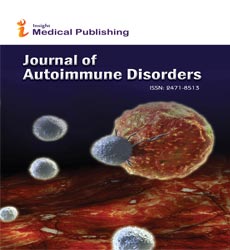The Role of Viral Infections in Triggering Autoimmune Responses
Lucas Schwartz
Department of Clinical Immunology, Sofia University St. Kliment Ohridski, Sofia, Bulgaria
Published Date: 2025-02-28DOI10.21767/2471-8513.11.1.112
Corresponding author:
Lucas Schwartz,
Department of Clinical Immunology, Sofia University St. Kliment Ohridski, Sofia, Bulgaria,
E-mail: lucas.s@sofia.bg
Received date: February 01, 2025, Manuscript No. ipado-25-2045; Editor assigned date: February 03, 2025, PreQC No. ipado-25-2045(PQ); Reviewed date: February 15, 2025, QC No. ipado-25-2045; Revised date: February 22, 2025, Manuscript No. ipado-25-2045(R); Published date: February 28, 2025, DOI: 10.21767/2471-8513.11.1.112
Citation: Schwartz L (2025) The Role of Viral Infections in Triggering Autoimmune Responses. J Autoimmune Disord Vol.11.No.1: 112.
Introduction
Autoimmune diseases arise when the immune system mistakenly targets the bodyâ??s own cells and tissues, leading to chronic inflammation and organ dysfunction. While genetic predisposition plays a significant role in determining susceptibility, environmental factors are often the catalysts that initiate or exacerbate autoimmune responses. Among these factors, viral infections have been consistently implicated as potential triggers of autoimmunity. Numerous clinical and experimental studies highlight how viruses can disturb immune tolerance and promote autoreactivity. Understanding the molecular and immunological mechanisms by which viral infections contribute to autoimmune diseases is essential for both prevention and therapeutic interventions [1].
Description
One of the most widely recognized mechanisms linking viral infections to autoimmunity are molecular mimicry. In this process, viral antigens share structural similarities with host proteins, leading the immune system to mount a response against both. For example, Epstein-Barr virus (EBV) antigens resemble self-antigens associated with Multiple Sclerosis (MS) and Systemic Lupus Erythematosus (SLE). Similarly, Coxsackievirus infection has been linked to type 1 diabetes (T1D), where viral peptides mimic pancreatic ò-cell proteins, resulting in immune-mediated destruction of insulin-producing cells [2,3].
Another mechanism is bystander activation, in which viral infection induces strong inflammatory responses that inadvertently activate autoreactive T and B cells. This occurs when viral replication and tissue damage release previously hidden self-antigens, making them visible to the immune system. Infections with hepatitis C virus (HCV) and human T-cell leukemia virus type 1 (HTLV-1) have been associated with this phenomenon, often leading to autoimmune hepatitis or neurologic autoimmune conditions. Additionally, persistent viral infections may drive chronic immune activation, disrupting regulatory T cell (Treg) function and enhancing the activity of pro-inflammatory cytokines such as IFN-ñ and TNF-ñ, which further promote autoreactivity [4].
Epstein-Barr virus, cytomegalovirus, and retroviruses exemplify how latent or chronic infections contribute to long-term immune dysregulation. By integrating into host cells or evading immune clearance, these viruses establish reservoirs that continually stimulate the immune system. Genetic susceptibility further amplifies this effect, as individuals carrying certain HLA alleles may present viral and self-antigens more effectively, heightening the risk of developing autoimmune diseases. This complex interplay between viral persistence, immune dysregulation, and host genetics underscores why only some infected individuals progress to autoimmunity [5].
Conclusion
Viral infections are significant environmental triggers that can initiate or exacerbate autoimmune responses through molecular mimicry, bystander activation, and chronic immune stimulation. While not all individuals infected with these viruses develop autoimmune diseases, those with genetic and epigenetic susceptibilities face a higher risk. Ongoing research aims to clarify the precise mechanisms and identify biomarkers that predict disease onset. Importantly, these insights pave the way for novel therapeutic strategies, such as vaccines that avoid cross-reactivity, antiviral treatments to reduce chronic infection, and immune-modulating therapies that restore tolerance. Understanding the role of viruses in autoimmunity is crucial for developing targeted prevention and personalized treatments for autoimmune disorders.
Acknowledgment
None.
Conflict of Interest
None.
References
- Sogkas G, Atschekzei F, Adriawan IR, Dubrowinskaja N, Witte T, et al. (2021). Cellular and molecular mechanisms breaking immune tolerance in inborn errors of immunity. Cell Mol Immunol 18: 1122-1140.
Google Scholar Cross Ref Indexed at
- Cho JH, Gregersen PK (2011). Genomics and the multifactorial nature of human autoimmune disease. N Engl J Med 365: 1612-1623.
Google Scholar Cross Ref Indexed at Green Version
- Fugger L, Jensen LT, Rossjohn J (2020). Challenges, progress, and prospects of developing therapies to treat autoimmune diseases. Cell 181: 63-80.
Google Scholar Cross Ref Indexed at
- Aaltonen J, Björses P, Perheentupa J, Horelli–Kuitunen N, Palotie A, et al. (1997). An autoimmune disease, APECED, caused by mutations in a novel gene featuring two PHD-type zinc-finger domains. Nat Genet 17: 399-403.
Google Scholar Cross Ref Indexed at
- Fisher GH, Rosenberg FJ, Straus SE, Dale JK, Middelton LA, et al. (1995). Dominant interfering Fas gene mutations impair apoptosis in a human autoimmune lymphoproliferative syndrome. Cell 81: 935-946.
Open Access Journals
- Aquaculture & Veterinary Science
- Chemistry & Chemical Sciences
- Clinical Sciences
- Engineering
- General Science
- Genetics & Molecular Biology
- Health Care & Nursing
- Immunology & Microbiology
- Materials Science
- Mathematics & Physics
- Medical Sciences
- Neurology & Psychiatry
- Oncology & Cancer Science
- Pharmaceutical Sciences
